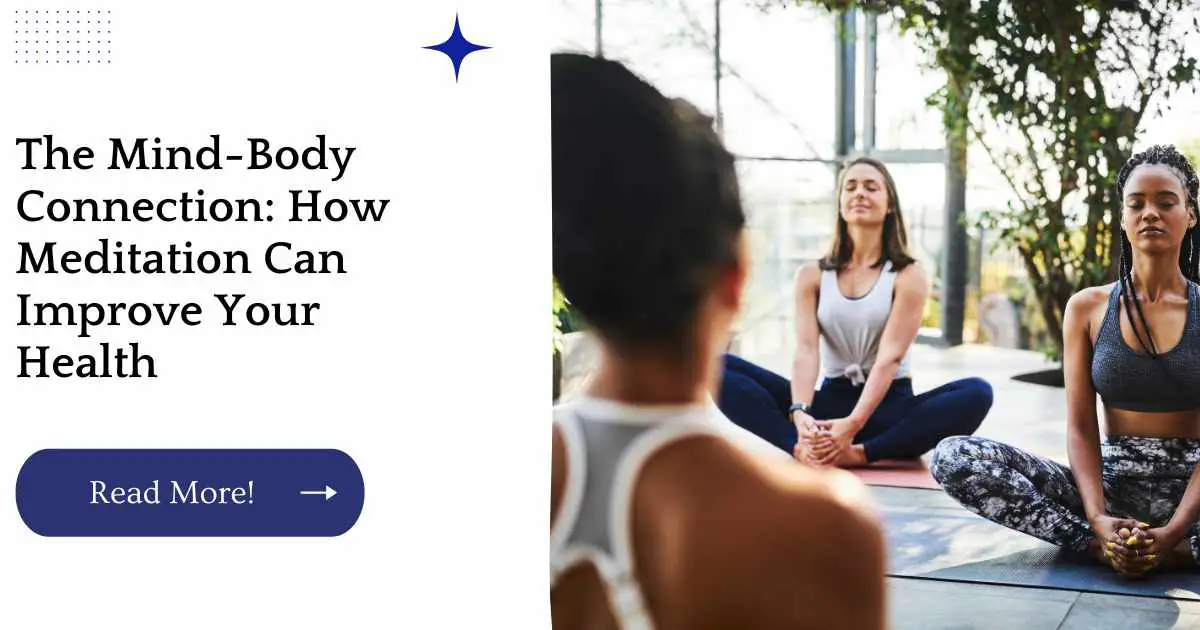The mind-body connection is a concept in which the mind and body are connected. This can be seen through various ways:
The mind influences the body, such as when you’re feeling stressed out and your heart rate increases.
The body influences the mind, like how exercise can make you feel happier or calmer than if you didn’t exercise at all.
The benefits of meditation include improved focus and concentration, reduced stress levels (which may lead to better sleep), increased self-esteem and confidence because of better coping skills for dealing with difficult situations in life–and more!
| Key points |
|---|
| The connection between the mind and body is powerful, and meditation can help to strengthen this connection. |
| Regular meditation practice has a wide range of benefits, including reduced stress and anxiety, improved mindfulness, and better overall health. |
| Incorporating mindfulness meditation into your daily routine can help you cultivate present-moment awareness and bring a greater sense of calm and balance to your life. |
| By combining meditation with other forms of exercise, such as cardio and strength training, you can improve both your physical and mental health. |
| There are many different types of meditation available, so it’s important to find the type that works best for you and your lifestyle. |
What is the Mind-Body Connection?
The mind-body connection is a concept that links mental and physical health. It’s the idea that how you feel can impact your body, and vice versa. For example, if you’re stressed out about something at work or school, this may cause physical symptoms like headaches or stomachaches.
On the other hand, if you’re feeling happy and relaxed after spending time with friends or family members who make you laugh often (which is known as “laughter yoga”), then it could help reduce stress levels in some cases.
Mindfulness meditation is one example of a practice that can improve both mental health by helping people focus their attention on things such as breathing exercises or guided visualizations while also improving physical health because it helps lower blood pressure levels while increasing immune system function over time through regular practice sessions over several weeks’ time period.”
The practice of mindfulness meditation has been proven to reduce symptoms of anxiety and stress by cultivating present-moment awareness. Our article on What is Mindfulness and How Can it Help Anxiety? provides practical tips to help you start your mindfulness meditation journey.
Benefits of Meditation
Meditation can help you to:
- Improve your health. Meditation can lower blood pressure, reduce stress and anxiety, and increase feelings of happiness.
- Develop better relationships with others. Meditation can help you to be more compassionate towards yourself and others, as well as improve communication skills in relationships by increasing self-awareness (the ability to recognize one’s own feelings).
- Improve focus at work or school by reducing distractions from outside sources such as noise or other people talking nearby while you are trying to concentrate on something else like studying for an exam or writing an essay on a computer screen that has many windows open at once!
Cardiovascular exercise is not only essential for maintaining a healthy weight but also for overall health and well-being. Check out our article on Why Cardio is Essential for Overall Health and Wellness to learn more about the many benefits of cardio and how it can improve your meditation practice.
Types of Meditation
There are many different types of meditation, and it’s important to know what each one is so you can decide which one is right for you.
Guided meditation: A guided meditation involves listening to an audio recording or having someone guide you through the process. This type of meditation can help beginners learn how to meditate and stay focused on their breath or other objects in their mind.
Mindfulness meditation: Mindfulness involves focusing on what’s happening in the present moment without judgment or thinking about past events or future plans–just being aware of what’s going on around you at that time.
This type of mindfulness practice has been shown to improve moods by helping people become less stressed out over small things like traffic jams or even just waiting in line at Starbucks! Transcendental Meditation (TM): This form of TM involves repeating a mantra while sitting quietly with eyes closed; it was developed by Maharishi Mahesh Yogi in 1955 but has been popularized recently thanks to celebrities like Katy Perry who say it helps them sleep better at night!
Types of Meditation
| Meditation Type | Description |
|---|---|
| Mindfulness Meditation | Focuses on bringing present-moment awareness to one’s thoughts, emotions, and physical sensations. |
| Loving-Kindness Meditation | Involves sending loving-kindness or positive energy towards oneself and others. |
| Body Scan Meditation | Involves focusing on each part of the body, from head to toe, and noticing any sensations or tension present. |
| Transcendental Meditation | Involves the use of a mantra or sound to achieve a deep state of relaxation and inner peace. |
| Vipassana Meditation | A type of insight meditation that encourages individuals to observe their thoughts and emotions without judgment. |
| Zen Meditation | Focuses on maintaining proper posture and breath control to achieve a deep state of relaxation and mindfulness. |
| Yoga Meditation | Involves combining physical postures, breathing exercises, and meditation to promote mental and physical well-being. |
The benefits of mindfulness reach far beyond just reducing stress and anxiety. Learn more about the science of mindfulness and its benefits with our article, The Science of Mindfulness: Understanding the Benefits.
How to Get Started with Meditation
To get started with meditation, you’ll want to find a comfortable place to sit. You can use a chair or cushion if you prefer. It’s also important that the room be quiet and free from distractions like televisions or computers.
Once you’ve found your ideal spot, set aside time every day at the same time (or as close as possible) so that it becomes routine for your body and mind. Try not to skip days in between sessions; this will help make meditation into something automatic rather than something extra that needs effort on your part each day.
Common Meditation Challenges
There are a few common challenges that people face when they start meditating. The most common one is staying focused, but there are also other issues that can arise.
Let’s take a look at some of the most common meditation challenges and how to overcome them:
Staying focused: If your mind keeps wandering during meditation, it may be hard for you to stay focused on what’s happening in the present moment. This is normal; everyone experiences this from time to time! Try using an audio guide or guided meditation app so that someone else can help keep track of where your attention should be at any given moment (and make sure not to judge yourself if thoughts come up).
Finding the time: Scheduling regular times for meditation can be difficult if it doesn’t fit into your schedule very easily–but don’t let this stop you! Set aside ten minutes every day (or even five) where nothing else matters except being present with yourself and others around you; those few minutes could make all the difference in how well rested and happy we feel throughout our lives.
Common Meditation Challenges
| Challenge | Solution |
|---|---|
| Difficulty focusing | Practice mindfulness techniques, such as focusing on the breath or repeating a mantra, to help maintain focus. |
| Physical discomfort | Experiment with different seated positions or try a guided yoga or body scan meditation. |
| Restlessness or boredom | Incorporate different types of meditation into your routine or try meditating in a new environment. |
| Time constraints | Start with shorter meditation sessions and gradually increase the time as you become more comfortable. Incorporate meditation into your daily routine. |
| Self-judgment or negative self-talk | Practice self-compassion and remind yourself that meditation is a practice, not a goal. Consider incorporating loving-kindness meditation into your practice. |
In a world full of distractions, finding moments of peace can seem impossible. Our guide on Finding Peace in a Busy World: The Practice of Meditation provides practical tips to help you incorporate meditation into your daily routine and find that inner peace you crave
Tips for Sticking with Meditation
Set realistic goals. You’re not going to sit down for 20 minutes and suddenly be able to meditate for an hour. Start small and build from there, like working up from 2 minutes per day to 10 minutes per day over a period of weeks or months.
Track your progress so you can see how far along the path you’ve come–and what still needs work!
Find an accountability partner who will hold you accountable by making sure that they know when and where in your schedule each session takes place (and if necessary, remind them).
Meditation Resources
- Books
- Online courses
- Apps
Meditation is a powerful tool for coping with stress and anxiety, helping to cultivate a sense of calm and balance in our lives. Learn how to integrate meditation into your routine with our guide on Meditation for Stress Relief: How to Find Calm in Chaos.
Conclusion
In conclusion, meditation is an effective way to improve your health and well-being. It’s not just about sitting quietly; it’s about learning how to focus your attention on the present moment. This can help you manage stress, reduce pain and anxiety, and even make you happier!
Further Reading
The Mind-Body Benefits of Meditation: This article explores the connection between meditation and the mind-body connection, as well as the numerous benefits that meditation can have for both physical and mental health.
Meditation and the Mind-Body Connection: This article discusses the ways in which meditation can improve the mind-body connection and ultimately improve overall health and well-being.
How Meditation Can Impact Your Health: This informative piece delves into the science behind the mind-body connection and how meditation can impact health and wellness.
FAQs
How can meditation improve the mind-body connection?
Meditation has been shown to improve the mind-body connection by increasing awareness of physical sensations, emotions, and thoughts, and helping individuals better understand the interconnectedness of their mental and physical states.
What are the benefits of meditation for physical health?
Meditation has been shown to have numerous benefits for physical health, including reducing inflammation, improving cardiovascular function, and boosting the immune system.
How does the mind-body connection impact mental health?
The mind-body connection plays a fundamental role in mental health, as the two are intimately connected. By improving the mind-body connection, individuals can experience reduced symptoms of anxiety, depression, and other mental health conditions.
Are there different types of meditation?
Yes, there are many different types of meditation, each with their own unique focus and practice. Some common types of meditation include mindfulness meditation, loving-kindness meditation, and body scan meditation.
Can anyone learn to meditate?
Yes, anyone can learn to meditate with practice and dedication. There are many resources available for beginners, including guided meditations and mindfulness apps.

Hi, I’m Hellen James! I’m a fitness enthusiast who has used her own experience to help others get fit and stay fit. I’ve been writing about home fitness for years, and now I’m finally putting together my own blog.


